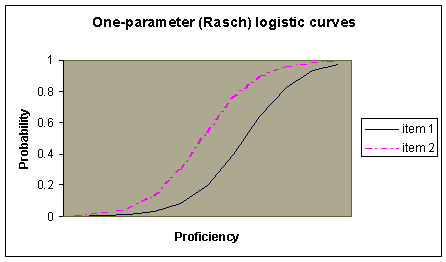The One-Parameter Logistic model uses an item response theory (IRT) model that specifies the probability of a correct response as a logistic distribution in which items vary only in terms of their difficulty. This model is used on multiple choice or short constructed-response items that are scored correct or incorrect, and do not appear to allow for guessing.
The simplest form of an item response model is a one-parameter model (1PL) also known as a Rasch model (1960). This model assumes that items vary only by difficulty (b). All items are assumed to have equal discriminating power (a) and the probability of a correct guess is zero. Hence, the model assumes that subjects with low ability are almost certain to miss the item and those with high ability are almost certain to answer the item correctly. The fundamental equation of the Rasch model is the probability that a randomly selected examinee with unobservable proficiency q on scale k will correctly respond to item j:

where
xj = the response to item j, 1 if correct and 0 if not;
bj = the threshold parameter of item j, characterizing its difficulty;
D = an arbitrary scaling constant typically set to 1.7 to approximate results
from the normal ogive model.
While the logistic model and the normal ogive model produce similar results after scaling, the logistic model is preferred due to its ease in computation (Hambleton & Swaminathan, 1995).
The figure below illustrates the 1PL logisitic curves for two items. As can be seen, the item characteristic curves (icc) vary only in their location along the proficiency scale. The location along the proficiency scale represents the difficulty of the item. The further the curve is to the right, the harder the item. Based on the location of the two curves, we conclude that item 1 is harder then item 2. The slopes of the two curves are identical, indicating that the two items are equally discriminating.

Crocker, L., & Algina, J. (1986). Introduction to Classical & Modern Test Theory. Fort Worth: Harcourt Brace Jovanovich College Publishers.
Hambleton, R. K., & Swaminathan, H. (1995). Item Response Theory: Principles and Applications. Norwell MA: Kluwer Academic Publishers.
Rasch, G. (1960). Probabilistic Models for Some Intelligence and Attainment Tests. Copenhagen: Denmarks Paedagogiske Institut.
Currently the parameters of the One-Parameter Logistic (Rasch) Model must be estimated through some other statistical software package and imported into AM. Future versions of AM software will allow the user to estimate both item and ability parameters.
TheThe One-Parameter Logistic model (1PL) is not used in scoring NAEP items. NAEP relies instead on the 2PL for multiple choice or short constructed-response items scored right or wrong and that do not appear to allow for guessing.